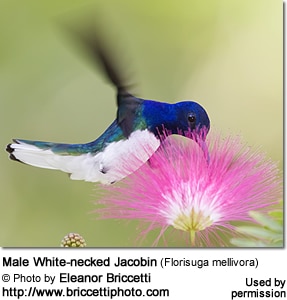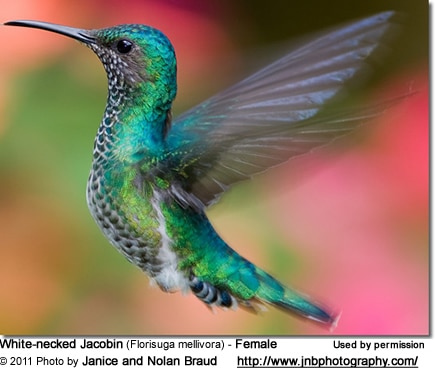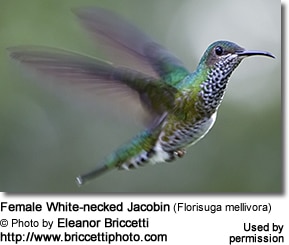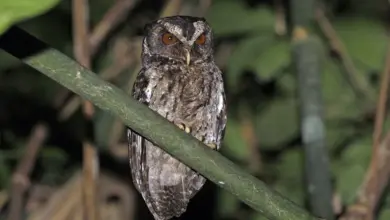White-necked Jacobins (Hummingbird)
The White-necked Jacobin (Florisuga mellivora) is also commonly known as the Great Jacobin, Jacobin Hummingbird, or Collared Hummingbird.
Alternate (Global) Names
Spanish: Colibrí cuello blanco, Colibrí de Nuca Blanca, Colibrí Nuca Blanca, Colibrí Nuqiblanco, Colibrí Nuquiblanco, Jacobino Nuquiblanco … Portuguese: Beija-flor-azul-de-rabo-branco, beija-flor-branco, beija-flor-da-copa … Italian: Giacobino collobianco, Succhiafiori collobianco… French: Colibri jacobin, Jacobine … Czech: Kolibrík belokrký, kolib?ík b?lokrký … Danish: Hvidnakket Jacobin … German: Finschia, Jakobiner Kolibri, Jakobinerkolibri, Weißnackenkolibri … Finnish: Mesikolibri … Japanese: shiroerihachidori … Dutch: Witnekkolibrie … Norwegian: Hvitnakkekolibri … Polish: Nektareczek b??kitna, nektareczek blekitny, nektareczek b??kitny
Russian: ???????-?????? … Slovak: jakobín bielošijí , Kolibrík bielošijí … Swedish: Halsbandsjakobin
Recognized Subspecies and Ranges
- White-necked Jacobin (Florisuga mellivora – Linnaeus, 1758) – nominate species
- Range: South Mexico to Panama and Colombia, South to West Ecuador, Southeast Peru and North Bolivia, and East to Venezuela, Trinidad, the Guianas, and Amazonian Brazil.
- Florisuga mellivora flabellifera (Gould, 1846)
- Range: Limited to the island of Tobago in the southern Caribbean Sea
- ID: Larger than the nominate species
Distribution / Range
This large and attractive White-necked Jacobin has a wide range, from southern Mexico south to Peru, Bolivia, and south Brazil. It is also found in Tobago and Trinidad, but breeding has not been proved on the latter island. It mainly occurs below 900m.
They are usually seen at a high perch or just above the canopy. They are less common at lower levels, except when feeding at hummingbird feeders.

Description
The male White-necked Jacobin averages 12 cm in length. He has a bright green upper plumage, a blue head, and a chest. He is easily identified by his white abdomen and mostly white tail. He also has a white band on the nape *back of the neck) and a dark blue hood.
Immature males have less white in the tail and a conspicuous rufous patch around the eyes.
Females may resemble adult or immature males. She is green above; her abdomen is white; her throat is white-scaled green or blue. The feathers under her tail surrounding the vent are white-scaled dark blue. Her plumage varies greatly and identification can be confusing. However, her vent coloration is distinctive and not shared by similar species.

Nesting / Breeding
Hummingbirds are solitary in all aspects of life other than breeding, and the male’s only involvement in the reproductive process is the actual mating with the female. They neither live nor migrate in flocks, and there is no pair bond for this species. Males court females by flying in a U-shaped pattern in front of them. He will separate from the female immediately after copulation. One male may mate with several females. In all likelihood, the female will also mate with several males. The males do not participate in choosing the nest location, building the nest, or raising the chicks.
The female White-necked Jacobin is responsible for building the cup-shaped nest out of plant fibers woven together and green moss on the outside for camouflage in a protected location in a shrub, bush, or tree. She lines the nest with soft plant fibers, animal hair, and feathers down, and strengthens the structure with spider webbing and other sticky material, giving it an elastic quality to allow it to stretch to double its size as the chicks grow and need more room. The nest is typically found on a low, thin horizontal branch.

The average clutch consists of one white egg, which she incubates alone, while the male defends his territory and the flowers he feeds on. The young are born blind, immobile, and without any down.
The female alone protects and feeds the chicks with regurgitated food (mostly partially digested insects since nectar is an insufficient source of protein for the growing chicks). The female pushes the food down the chicks’ throats with her long bill directly into their stomachs.
As is the case with other hummingbird species, the chicks are brooded only the first week or two and are left alone even on cooler nights after about 12 days – probably due to the small nest size. The chicks leave the nest when they are about 7 – 10 days old.
Diet / Feeding
The White-necked Jacobins primarily feed on nectar taken from a variety of brightly colored, scented small flowers of trees, herbs, shrubs, and epiphytes.
Hummingbird Resources
- Hummingbird Information
- Hummingbird Amazing Facts
- Attracting Hummingbirds to Your Garden
- Hummingbird Species
- Feeding Hummingbirds





